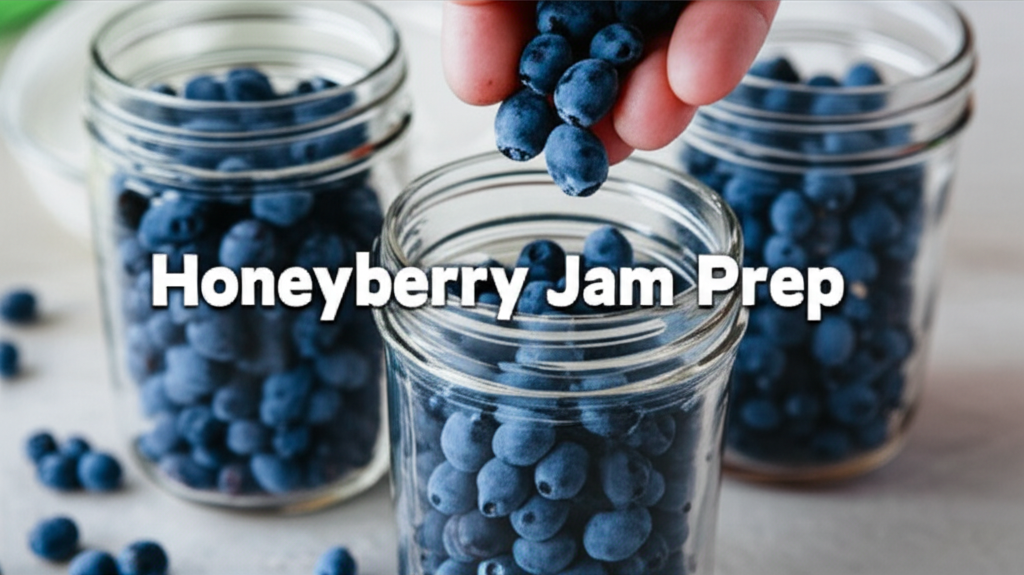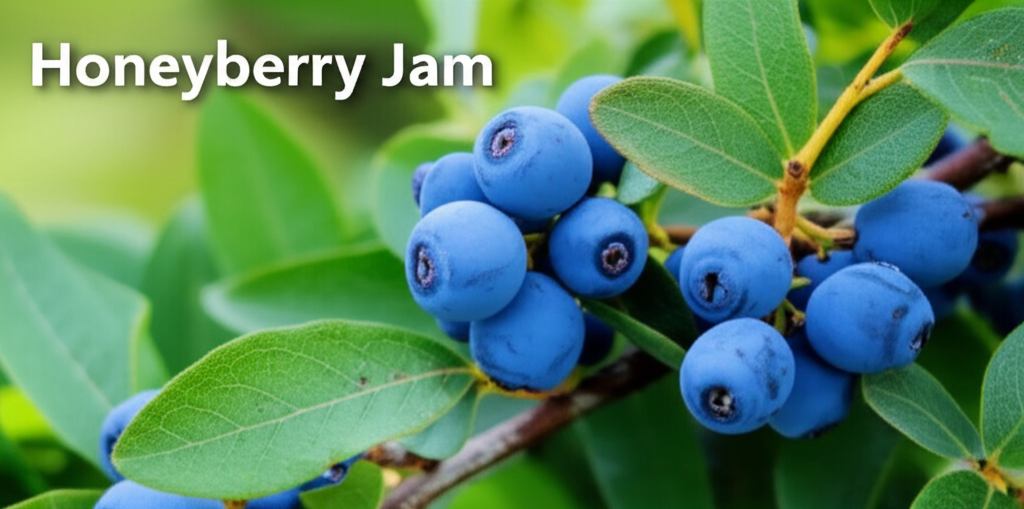Introduction to Honeyberry Jam: A Sweet and Tart Delight
Honeyberries, also known as haskap or edible honeysuckle, are fascinating fruits gaining popularity for their unique flavor profile – a delightful blend of blueberry tartness with a hint of raspberry sweetness. These hardy shrubs are native to northern latitudes and produce an early-season harvest, often ripening before strawberries. Their nutritional benefits are also impressive, boasting high levels of antioxidants, vitamin C, and anthocyanins.
For home gardeners and fruit enthusiasts alike, preserving the fleeting harvest of honeyberries into delicious homemade jam is a rewarding endeavor. This guide will walk you through the entire process, from selecting the best honeyberries to storing your finished jars of vibrant, flavor-packed jam. We’ll cover everything you need to know to create a pantry staple that extends the enjoyment of these exceptional berries throughout the year.
Why Preserve Honeyberries as Jam?

The advantages of transforming fresh honeyberries into jam are numerous. Firstly, it’s an excellent method for preserving the fruit’s bounty, especially if you have a prolific harvest. Honeyberries are relatively delicate and have a short shelf life when fresh. Jamming them allows you to enjoy their distinct taste long after the season has passed.
Beyond preservation, honeyberry jam offers a unique flavor experience. Its inherent tartness balances beautifully with sweetness, creating a sophisticated jam that’s versatile in its applications. It’s perfect on toast, scones, or yogurt, but also shines in more culinary roles, such as a glaze for meats or a filling for pastries.
Finally, making your own jam provides a connection to your food and a sense of accomplishment. You control the ingredients, avoiding artificial preservatives and excessive sugar often found in commercial products. This is particularly appealing for those focused on wholesome, homemade goodness.
Key Facts About Honeyberries and Jam Making
| Characteristic | Honeyberry Fruit | Honeyberry Jam |
|---|---|---|
| Flavor Profile | Tart, slightly sweet, hints of blueberry and raspberry | Sweet and tart, intensified berry flavor |
| Texture | Oblong, juicy, small seeds | Smooth or with small berry pieces, gelatinous consistency |
| Pectin Content | Moderate to low | Requires added pectin or high-pectin fruits for proper setting |
| Acidity | High | Contributes to tartness and aids in preservation |
| Best Ripeness for Jam | Fully ripe, slightly soft | N/A (processed fruit) |
| Seasonality | Early summer | Available year-round through proper preservation |
Selecting and Preparing Honeyberries for Jam
The quality of your honeyberry jam begins with the quality of the fruit.
Choosing the Right Honeyberries
- Ripeness: Select berries that are fully colored (usually a deep blue or purple) and slightly soft to the touch. Underripe berries will be too tart and may not have developed their full flavor. Overripe berries can become mushy and lose some of their vibrant taste.
- Condition: Inspect the berries for mold, bruising, or signs of insect damage. Only use fresh, undamaged fruit for the best jam.
- Variety: Different honeyberry varieties may have slight variations in flavor and sweetness. Experimenting with different types can lead to discovering your favorite jam profile.
Washing and Hulling
Gentle handling is crucial with honeyberries.
- Washing: Place the harvested berries in a colander and rinse them gently under cool running water. Avoid agitating them too vigorously, as this can cause them to break down.
- Draining: Allow the berries to drain thoroughly. You can spread them on a clean kitchen towel or paper towels to absorb excess moisture.
- Hulling: Honeyberries do not have prominent hulls like strawberries. Any small stem remnants can usually be removed by gently picking them off or by the rinsing process.
The Art of Honeyberry Jam Making: A Step-by-Step Approach
Making honeyberry jam involves a few key steps to ensure a delicious and well-set product. This recipe is a basic framework; feel free to adjust sweetness and add complementary flavors.
Basic Honeyberry Jam Recipe
This recipe yields approximately 4-5 half-pint jars.
Ingredients:
- 4 cups (about 2 pounds) fresh honeyberries, rinsed and drained
- 3 cups granulated sugar (adjust to taste, but essential for setting and preservation)
- 1/4 cup lemon juice (freshly squeezed)
- 1 packet (1.75 oz) powdered fruit pectin (e.g., Sure-Jell, Ball)
Equipment:
- Large, heavy-bottomed saucepan
- Wooden spoon or heat-resistant spatula
- Jars and lids (sterilized)
- Canning funnel
- Ladle
- Water bath canner or large pot with rack
- Jar lifter
- Clean cloths
Step-by-Step Instructions:
- Prepare Your Jars and Lids: Sterilize your jars and lids according to canning guidelines. This typically involves washing them thoroughly and then boiling them in water for at least 10 minutes. Keep them warm until ready to fill.
- Combine Fruit and Lemon Juice: In the large saucepan, combine the prepared honeyberries and lemon juice.
- Mash the Berries (Optional): For a smoother jam, you can gently mash some or all of the berries with a potato masher or the back of your spoon. For a chunkier jam, leave them whole or lightly crush them.
- Add Pectin: Stir the powdered pectin into the fruit mixture.
- Bring to a Rolling Boil: Place the saucepan over high heat and stir constantly until the mixture reaches a full, rolling boil – one that cannot be stirred down.
- Add Sugar: Immediately add the sugar to the boiling mixture. Stir constantly until the sugar is completely dissolved.
- Boil Until Set: Return the mixture to a full rolling boil and boil for exactly 1 minute, stirring constantly. This brief, high-heat boil is crucial for activating the pectin and achieving a proper set.
- Skim Off Foam: Remove the saucepan from the heat. Skim off any foam that has accumulated on the surface using a spoon.
- Fill Jars: Carefully ladle the hot jam into the sterilized jars, leaving 1/4 inch of headspace at the top.
- Wipe Rims and Apply Lids: Wipe the jar rims clean with a damp cloth to ensure a good seal. Place the lids on the jars and screw on the bands until fingertip tight.
- Process in Water Bath Canner: Place the filled jars in the water bath canner filled with enough hot water to cover the jars by at least 1 inch. Bring the water to a rolling boil. Process the jars for 10 minutes (adjusting for altitude if necessary).
- Cool Jars: Carefully remove the jars from the canner using a jar lifter and place them on a towel-lined counter to cool undisturbed for 12-24 hours. You should hear the lids pop as they seal.
- Check Seals: After cooling, check that the lids are sealed. Press the center of each lid; if it doesn’t flex, the jar is sealed. If a lid hasn’t sealed, refrigerate the jam and use it within a few weeks.
- Store: Unopened, properly sealed jars of honeyberry jam can be stored in a cool, dark place for up to a year.
Troubleshooting and Tips for Perfect Honeyberry Jam
Even with careful preparation, jam making can sometimes present challenges. Here are some common issues and helpful tips:
Common Jam-Making Problems and Solutions
- Jam Not Setting: This is often due to insufficient boiling time, not enough sugar, too much fruit, or an inactive pectin. Ensure you boil for the recommended time, use the correct sugar-to-fruit ratio, and check the expiration date on your pectin. You can re-boil the jam with additional pectin if it remains too liquid.
- Foamy Jam: While some foam is natural, excessive foam can be reduced by adding a small knob of butter or margarine to the jam just before it boils. Skimming off foam also helps.
- Crystallized Jam: This can happen if the sugar doesn’t fully dissolve or if the jam is boiled for too long. Ensure sugar is fully dissolved before the rolling boil and adhere to the recommended boiling time.
- Cloudy Jars: This can occur if the jars are not properly sterilized, if there are air bubbles trapped, or if the jam is too thick when filling.
Advanced Tips and Flavor Variations
- Using Natural Pectin: If you prefer not to use commercial pectin, you can increase the pectin content by adding other high-pectin fruits like apples, crabapples, or citrus peels (from organic, unwaxed fruits).
- Flavor Enhancements: Honeyberry jam pairs wonderfully with other flavors. Consider adding:
- A pinch of cinnamon or cardamom for warmth.
- A splash of vanilla extract for depth.
- A bit of finely grated ginger for a zesty kick.
- Complementary fruits like raspberries, blueberries, or even a few chopped strawberries.
- Reducing Sugar: While sugar is crucial for preservation and setting, you can experiment with slightly reducing it if your honeyberries are particularly sweet. However, be cautious, as too little sugar can impact the jam’s shelf life and setting ability.
- Using a Candy Thermometer: For more precise setting, you can use a candy thermometer. Jam is typically ready when it reaches 220°F (104°C) at sea level, though pectin recipes often rely on time.
Storage and Enjoyment of Honeyberry Jam
Proper storage ensures your homemade honeyberry jam remains delicious and safe to consume.
Storage Guidelines
- Unopened Jars: Store sealed jars in a cool (65-75°F or 18-24°C), dark, and dry place. Avoid extreme temperature fluctuations. Properly sealed jars can last for up to 12 months.
- Opened Jars: Once opened, refrigerate the jam and consume it within 3-4 weeks for the best quality.
- Freezing: If you have excess jam or jars that didn’t seal properly, you can freeze it. Transfer the jam to freezer-safe containers, leaving adequate headspace for expansion, and it can be stored for up to a year.
Creative Ways to Enjoy Honeyberry Jam
- Classic Pairings: Spread generously on toast, croissants, muffins, or scones.
- Breakfast Boost: Swirl into yogurt, oatmeal, or pancakes.
- Dessert Enhancement: Use as a filling for cakes, cookies, or tarts. Drizzle over ice cream or cheesecake.
- Savory Applications: As a glaze for grilled meats (pork, chicken), a topping for cheese boards, or mixed into vinaigrettes for a sweet and tangy dressing.
- Beverage Ingredient: Stir into sparkling water or iced tea for a refreshing berry drink.
Comparison of Preservation Methods for Honeyberries
While jam is a fantastic way to preserve honeyberries, it’s helpful to consider other methods for context and to understand the benefits of each.
| Method | Pros | Cons | Best Use Case |
|---|---|---|---|
| Jam Making | Long shelf life, versatile flavor, pleasant texture, easy to process | Requires added sugar and pectin, cooked product changes flavor profile | Year-round enjoyment, versatile culinary uses |
| Freezing Berries | Preserves fresh flavor and nutrients, simple process | Takes up freezer space, texture changes upon thawing, requires defrosting | Maintaining fresh berry texture for smoothies, baking, or cooking |
| Drying (Dehydrating) | Concentrated flavor, space-saving, long shelf life | Changes texture significantly, requires a dehydrator or oven, can become very sweet | Snack food, adding to trail mix, rehydrating for baking |
| Juicing | Versatile for drinks, sauces, and syrups | Requires a juicer, can be less substantial than jam, often needs added sugar/preservatives | Creating juices, syrups, and adding to marinades |
Conclusion: Savoring the Sweetness of Homemade Honeyberry Jam
Preserving honeyberries through jam making is a fulfilling way to capture their unique, delightful flavor and enjoy them throughout the year. By understanding the selection, preparation, and careful execution of the jam-making process, you can create a pantry staple that is both delicious and rewarding. Whether spread on your morning toast or incorporated into a sophisticated dessert, homemade honeyberry jam is a testament to the simple pleasures of preserving nature’s bounty. Embrace the process, experiment with flavors, and savor every spoonful of this exquisite berry preserve.


